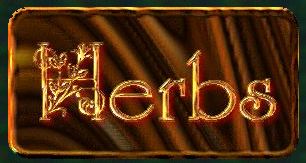Introduction
Technically,
the word “herb,” in its narrowest sense, refers only to seed-producing
plants that do not produce persistent woody tissue and die down at the end of
the growing season.
For
our purposes, however, we will claim a much more liberal definition, using the
term to refer to any plant or plant part valued for medicinal, Magickal (the
term, “Magick,” is given the archaic spelling, with the “k” at the end,
to distinguish real Magick, which works actual change on people and their
surroundings, from sleight-of-hand, stage magic or parlor magic), savory or
aromatic purposes.
Since the dawn of
time, our ancestors have used plants for more than just food.
In fact, some of the earliest known gravesites showed that our most
distant human ancestors frequently buried herbs with the dead.
Picture our
primitive ancestors, eating for survival. They
probably experimented with anything that didn’t eat them first.
Plants were certainly easier to catch than fleet-footed animals, so it
would have been logical for them to try some of everything.
They would have
quickly discovered not only that some tasted better than others, but also that
some had other effects than merely filling the bellies.
First, they must have noticed that various plant materials, whether taken
internally or used for other purposes, such as clothing, etc., had a variety of
effects. Some were tasty and/or
nourishing, while others were toxic. Some
had psychotropic or hallucinogenic properties, and still others seemed to have
special powers that were, quite literally, Magickal.
It is probable
that our ancestors learned many of these things even before the discovery of
fire.
Once
they discovered fire, using a variety of plants to feed the flames, they would
have noticed that the smoke had still more and different properties than the
plants when ingested.
Historically,
most of the knowledge acquired about herbs came from the simplest kind of
research imaginable: trial and error. Our
ancestors ate, drank, burned and otherwise used plants for a variety of reasons. Some worked while others did not. Over the millennia, a vast repertoire of folk wisdom about
plants has emerged.
Ancient Sumerian, Babylonian, Chaldean, and
Egyptian civilizations carried Herbalism to a high level, but it is probable
that no human cultures raised the level of herbal medicine to the levels
attained by those of China, India or the Druids of Ancient Britain.
And the Druids had no equals in the use of herbs for Magick.
It
is important to remember, however, that the boundaries between science and
Magick have always been blurry at best.
When a village Witch made a potion by boiling the bark of a willow tree
to fight fever, or a poultice of moldy bread to keep wounds from becoming
infected, it was called Magick.
When a chemist extracted one of the principal ingredients of the
willow-bark potion and made a pill, or the moldy bread and dried it into a
powder, it was called Science.
The pill was called “aspirin,” from the Latin prefix, “a,”
meaning “from,”
and “spirea,”
meaning “willow.”
The moldy bread extract became better known as “penicillin.”
The vast majority
of today’s medicine is rooted quite literally in the fertile soil of Magick
and has been derived from plants used for centuries by indigenous peoples in all
parts of the world.
It is especially
ironic that at this time, when serious researchers are investigating legends and
folk remedies in a rush to find new medicines, the rate of extinction for plant
and animal species has reached a level never seen before.
The last members of a species of plants from which the cures for cancer,
Multiple Sclerosis, AIDS, or any of a variety of life-threatening or
life-limiting illnesses might have been derived could be lost in to burning or
clear cutting in the Rainforest, or buried under the blades of a tractor to make
way for another parking lot.
  
  

|

